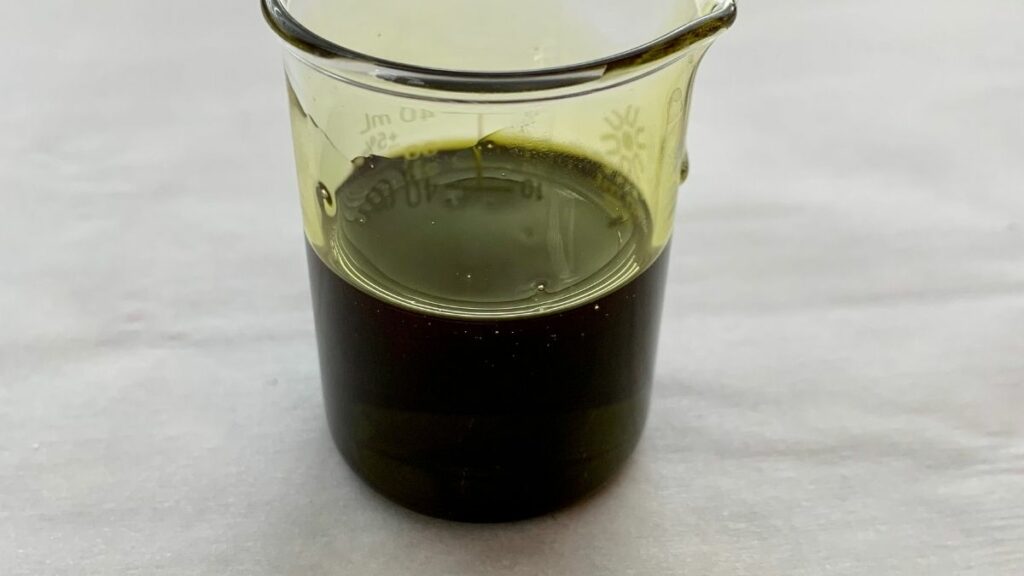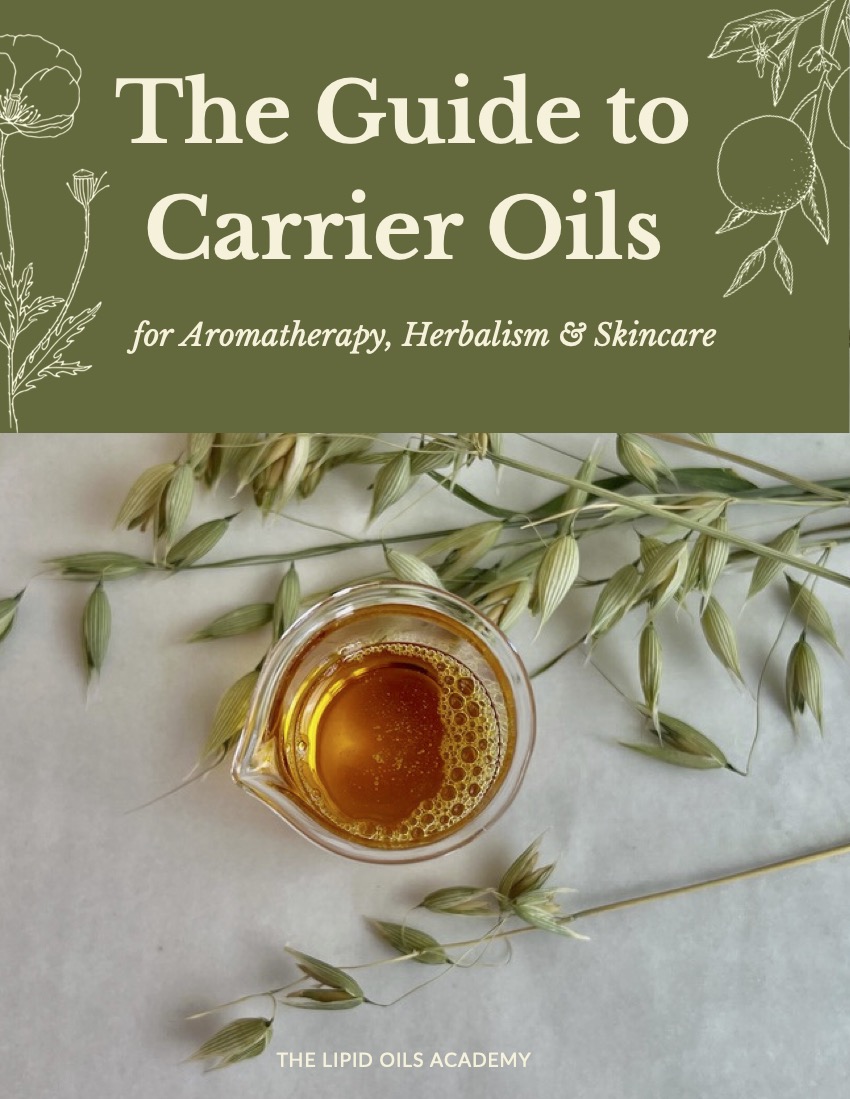Hemp seed oil seems to be showing up in more and more skin care products, and with good reason.
It has skin nourishing and anti-inflammatory properties.
Let’s look at hemp seed oil for skin care, plus devise a few recipe ideas for facial oils using this dark green, nutritious oil.
Fatty Acids & Anti-Inflammatory Properties
Hemp seed oil is very high in linoleic acid (56%). Linoleic acid is an Omega 6 fatty acid and one of the two essential fatty acids, important for nourishing the skin.
Next up we have Alpha-linolenic acid, the other essential fatty acid that is an omega 3 fatty acid. Equal to linoleic acid, it is an important fatty acid for controlling and treating inflammation in the skin.
In hemp seed oil we find the alpha-linolenic acid at 20% of the fatty acid profile. This is the main contributor to the anti-inflammatory properties in hemp seed oils.
Fatty Acids in Hemp Seed Oil
Linoleic acid 55% – an omega 6 fatty acid
alpha-Linolenic acid 20% – an omega 3 fatty acid
Oleic acid 14% – an omega 9 fatty acid
GLA – Gamma-linolenic acid 3% – an omega 6 fatty acid
SDA Stearidonic acid – 2% – an omega 3 fatty acid
Saturated fatty acids 12%
Though hemp seed oil only contains 3% GLA, it has valuable anti-inflammatory properties. Even at the small percentage we find it at in hemp seed oil, it contributes important skin healing properties to the oil.
From the fatty acid profile, we can see that hemp seed oil has a variety of Omega 3, 6, and 9 fatty acids. These are all unsaturated fatty acids.
Hemp seed oil is pressed from the seeds of Cannabis sativa or indica. It is not a CBD product which is extracted from the leaves and flower of the plant, not the seeds.
The Healing Fraction
Most hemp seed oil is cold pressed and unrefined (it is the refinement process that stripes out the color, scent and along with it the vitamins, minerals and other elements in the unsaponifiables portion of the oil.
Two important plant compounds in hemp seed oil are beta-sitosterol and campesterol. These are both plant sterols that have powerful anti-inflammatory properties.
Combined with the 20% alpha-Linolenic acid, the Gamma-linolenic acid and these two plant sterols make hemp seed oil particularly healing and anti-inflammatory.
A good unrefined hemp seed oil will also contain minerals, potassium magnesium, and zinc along with carotenoid compounds and vitamin E.
All the lipid oils are made up predominantly of fatty acids, usually 90% to 99% or more, relegating the unsaponifiable healing fraction to just a couple of percentage points.
Working with Hemp Seed Oil
Now that we have an idea of what is in hemp seed oil, let’s talk a little about how to use it.
Most hemp seed oil I have worked with ranges from brown to very dark green in color which can make it a bit of a challenge to work with!
Add too much and your facial oil will leave people looking a little green, temporarily of course, but user experience is important.
It is also a super ‘oily’ oil.
Some oils feel ‘dry’ and absorb quickly, while others are ‘oily’ feeling and tend to sit on the skin.
In a facial oil, I would recommend experimenting with about 20 to 25% hemp seed oil to get all the benefits in hemp seed oil without creating too heavy feeling facial oil.
Here are a few combination ideas:
For inflammation – combine evening primrose oil or borage with the 20% hemp seed oil with a neutral base oil like almond or camellia.
For blemishes and problem skin – combine hemp seed oil with black seed oil or watermelon seed oil. Both black seed oil and watermelon seed oil are especially good for acne and breakouts.
For nourishing and supporting dry skin – combine hemp seed oil with a super-rich oil like pomegranate, argan oil, or cranberry. You could create a combination of all four of these to make an especially rejuvenating oil serum.
You can also add hemp seed oil to your herbal balms and butters as part of the liquid oil portion to take advantage of the anti-inflammatory properties.
How are you using hemp seed oil?
Leave a comment below



I will definitely be trying it in lip balms
I am definitely going to try evening primrose oil and hemp seed oil for inflammation ,
Thank you!
I use it with yarrow pom. Also in salads as dressing.
Thanking for sharing very interesting information. I am using in balms at them moment and love the feel!
very interesting and valuable information
I am much appreciative of all your knowledge and for your teachings
Hi, Thank you for this information. I am thinking of making hand balms. I would like to combine it with baobab and shea butter. What are your thoughts on it?
Hello! This is really interesting – I do love hemp seed oil. How do you think it would combine with Sea Buckthorn? As well as a few other oils, for a facial oil that it anti ageing, balancing and rejuvenating? I want it to smooth but also soothe and prevent any hormonal breakouts for normal to combo skin. Thanks!
Hemp is a great oil to combine into facial oils. Along with sea buckthorn, it would be very nourishing for the skin.
So is hemp oil still a good carrier for skin creams. I’m assuming it’s different from hemp seed oil.
Hemp oil and hemp seed oil are the same thing. Oils from plants are pressed primarily from the seeds. There are a few exceptions but seeds, kernels, grains, beans are essentially seeds. The CBD ‘oils’ are extracts of the leaves and flowers I believe, and very different.
In this article you will get to know about the hemp seed oil for the skincare formulating. It is a wonderful to know about so many things that are useful for all of us!! Thanks a lot for this amazing blog. I loved this article, thanks for producing such a great content. I loved your posts always.
Hi. I have seen some manufacturers of skincare describe this oil as a ‘Dry Oil’, I was confused by this as when I have use it (long time ago now) it was thick and oily.
A better term than dry oil (meaning not oily) is drying oil. You could literally use the oil to make paint just as flax seed oil is linseed oil for paints and inks. It’s highly polyunsaturated so it will oxidize readily and dry.
Thank you so much for these great information. I have just discovered you through my Tisserand courses with LisaLise. I bought your book! Wow! So much precious info about oils. Thanks again
Hi Susan, I have combined Hemp Seed oil with Moringa, Jojoba, Evening Primrose and Olive squalane in a face serum formulation.
Hi Susan. Thanks for sharing this great info. Would hemp seed oil be good to use for Molluscum contagiosum? I have used Melissa eo diluted in Tamanu oil and although it seems to lessen the rash, it still not totally go away. I was using Tamanu because of the scars this rash leave on her back. I am looking to make a blend to clean the rash as well as heal the skin on my (teen) daughter’s shoulder and front area.
Hi Lyne, I couldn’t say for sure but it would be worth a try. Good luck with it.
There a really good Molluscum contagiosum recipe developed by Rhiannon Harries that works well. Searchable on net.
I keep it in a pump bottle and use it on my hands to help ease the achiness.
I have always known how amazing Hempseed oil is. I appreciate knowing exactly what makes it so, thank you so much Susan.
I use Hempseed oil in my face lotion and in my mums’ face oil.
I have a liter of it in, so I will start incorporating it into more products.
Its rancidity is the issue I have working with it. It goes rancid quickly and not a great potential for products to be used long term. How can this be dealt with apart from the inclusion of tocopherol
Yes tocopherols but also combining with meadowfoam seed oil at 20 to 35% can help retard oxidation.
Treat with bleaching clay and filter. It lowers the peroxide value which reduces the rancidity.
Hemp seed oil is in just about everything I formulate. I am building my brand around Hemp, the hero product of my line!